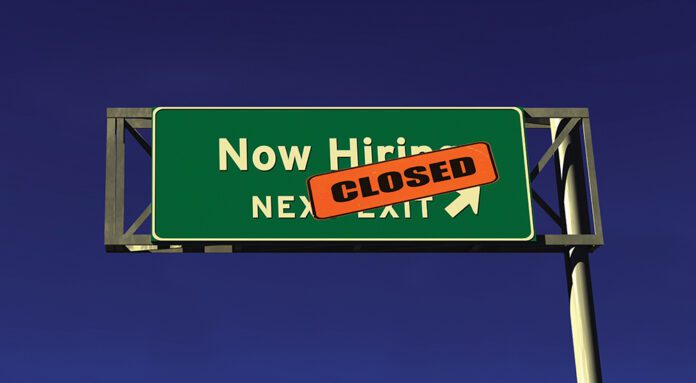
Multiple experts in the automotive industry believe that tariffs imposed by the administration of President Donald Trump are causing most Tier One suppliers to halt hiring for open positions and may result in a wave of staff layoffs before the end of this year.
But if the tariff picture is settled, there are positive signs ahead for the automotive industry from the federal spending signed into law in early July to a state research and development grant.
Despite the presence of tariffs, the U.S. economy added a stronger-than-expected 147,000 jobs in June, while the unemployment rate slightly fell to 4.1% from 4.2%, according to Bureau of Labor Statistics data released on July 3.
Notably, U.S. private sector businesses added 74,000 jobs in June, the smallest monthly gain since October 2024. This strong jobs report is one reason the Federal Reserve has referenced in its decision to maintain existing interest rates.
Automotive suppliers and vehicle manufacturers specifically are in a holding pattern with hiring because they are looking for a steadier path to certainty in relation to tariff costs and impact, said Sam Fiorani, Vice President of Pennsylvania-based Global Vehicle Forecasting at AutoForecast Solutions. Auto suppliers can’t increase their staffing because they don’t know what the tariff situation will be in the near- or mid-term.

“Everything is on hold and waiting for tariffs to settle in, and that includes hiring,” Fiorani says. “The EV market needs to be in a more confident direction before they start hiring and making investments. It’s all coming to a head at the moment to the point where these suppliers can’t really plan where to spend money.”
Michigan Manufacturing Association President John Walsh agrees with this sentiment. In mid-June Trump threatened non-auto tariffs on a variety of countries at 30 percent or more and maintained a general automotive industry tariff of 25 percent. Tariff talk has dominated many of the financial headlines since February.
That has been a stressful time for auto suppliers, Walsh says.
The MMA hosts or participates in roundtables designed to provide information to members about how tariffs will impact them. Suppliers that manufacture and ship domestically aren’t impacted but those tend to be smaller companies and aren’t reflective of the market as a whole.
Walsh says that just about every automotive supplier contact he has spoken with has put their hiring decisions on hold, echoing Fiorani’s sentiments. That is difficult because there are some open positions that need to be filled, especially when planning is ongoing for new makes and models.
“I would say that yes, hiring decisions are on hold across the board,” Walsh says. “I was just talking (in mid-June) with a company that had 300 employees and works in both automotive and defense. They aren’t as impacted by tariffs because they are more (versatile), but they are not hiring, either. There’s too much uncertainty.”
Corp! reached out to multiple Tier One suppliers including Denso, Lear and Magna to ask if tariffs have impacted their current hiring practices or trends. None of those companies were willing to talk on the record.
Many auto suppliers employ no more than 20 percent temporary workers during a normal operational period, but some of those companies are adding temporary staff if they need to because they don’t want to commit the longer-term costs, Walsh says. However, having that high of a percentage of a workforce as temporary staff is “not sustainable,” he adds.
“You have some companies that are panicking but regardless, it causes (challenges) upstream in the supply chain,” Walsh said. “It’s tough to spend any money if that (tariff) uncertainty continues. We need certainty (in the industry). We want to be open for free trade.”
Consumers, and some suppliers, haven’t felt the pain of tariffs yet because auto industry companies built up their supply as much as possible earlier this year when it became clear the Trump Administration intended to impose tariffs.
While that was a good strategy in the short-term, the auto industry is so attuned to Just in Time (JIT) manufacturing that they don’t have the storage to maintain extra supplies long-term., Walsh says.
In some ways, the fact that suppliers are also halting their capital investments is even worse. That can cause delays for 2026 model year vehicles, causing the supply chain to slow down, and impacting both vehicle capacity and prices now and in the future, Fiorani says.
In many ways, the auto industry as a whole was in a better place four or five months ago when newly imposed tariffs on U.S. imports became news. The problem, Fiorani says, is that there are more questions about tariffs today. There was hope among industry leaders that there would be more certainty by the summer. That hope has faded.
“While the (Trump) administration hints that negotiations with a number of countries are coming, it’s hard to know if that’s happening,” Fiorani says. “(The activity) doesn’t seem to be strong enough for any company to make a prediction as to where market will be in six to 12 months to year.”
Small suppliers may be even more significantly impacted. A June 2025 article in the Detroit Free Press suggested that the Trump Administration’s tariff rate could create significant job losses for smaller suppliers, putting their existence at risk.
The Free Press article highlighted Auburn Hills-based Lucerne International, a forging, casting, machining and assembly services manufacturer, which is hoping to be granted foreign trade zone status from the federal government. That would allow the supplier to delay its tariff bills and generate additional cash flow.

Lucerne CEO Mary Buchzeiger told the paper, “I wake up in the morning and I deal with tariffs. I go to bed, and I deal with tariffs. Then the policy keeps changing and when that playbook continuously keeps changing.”
While large-scale layoffs in the auto manufacturing sector haven’t started yet, Walsh anticipates many automotive suppliers will start laying employees off before the end of 2025.
“I’m hearing it should happen this year, because of the added (tariff-related) expenses,” he says. “I don’t think it falls to next year.”
One area where auto supplier might consider hiring for is data engineers and data scientists, says Mike Capone, CEO of Qlik, a Philadelphia-based company that makes artificial intelligence-based tools that help other companies analyze data. One of Qlik’s primary industry sectors is automotive, where margins for suppliers can be razor thin.
Capone says that professionals with supply chain experience who can analyze and properly interpret data can have an outsized impact on their company’s fortunes. The challenges with tariffs require significant analysis and mapping out potential scenarios that can help suppliers to make informed decisions in uncertain times.
Today’s auto manufacturers and suppliers rely on a mix of operational data, such as production performance and supply chain disruptions, alongside financial metrics and external factors like tariffs, Capone says. As a result, workforce performance data has become critical as companies align their talent strategies with new technology investments.
Capone says that despite the presence of tariffs, automakers and suppliers have consistently communicated their need for data engineers and data scientists has surged drastically.
“As the industry navigates ongoing tariff impacts and persistent supply chain challenges, these data experts have become business critical for driving smarter decisions and maintaining a competitive edge,” he says.
Despite that area of need, Qlik has uncovered cost pressures stemming from energy, raw material price volatility, and the growing investments in electronic vehicle technologies. Capone says that automotive suppliers are experiencing additional pressure fueled by labor shortages and higher wages.
“Unstable trade policies have really accelerated supply chain challenges,” Capone says. A recent survey fielded by Qlik revealed that the automotive industry is looking to source more from domestic suppliers and leveraging free trade zones in order to reduce tariff exposure compared to other industries like non-automotive manufacturing and aerospace.
Some Michigan legislators that MMA officials have spoken with are worried about the impact of layoffs in their districts, but Republicans are displaying more patience with the hope that the long-term effects of tariffs will help their districts, Michigan and the U.S. as a whole.
Walsh uses the term “angst” when referencing both the mood of auto industry employees and some legislators who are hearing from trade groups like the MMA and constituents who are worried about their jobs. Capone stops short of using the term “desperation” but admits that “concern” is a legitimate adjective.
MMA officials are in regular contact with legislators to express their concern over the impact of tariffs and Walsh encourages residents to contact their elected officials as well. The MMA works closely with the National Association of Manufacturers to communicate the challenges faced by auto suppliers.
“The most we can do is convey our concerns,” Walsh says.
The threat of short-term job loss for autoworkers didn’t seem to be a concern for the United Auto Workers earlier this year. UAW President Sean Fain expressed his support for the tariffs in May despite criticizing the Trump Administration on other issues. Fain told CNN that tariffs could help attract “thousands of good-paying blue collar auto jobs” back to the U.S. in the near-term. That could be accomplished by adding shifts or lines in existing or newly retrofitted U.S. plants, Fain said.

“Right now, thousands of autoworkers are laid off at Ford, General Motors, and Stellantis following recent decisions by auto executives to ship jobs to Mexico,” Fain said in a May UAW statement.
Until and if that happens, short-term hiring is one of several challenges faced by suppliers tied to the tariff situation, Fiorani adds. Hiring is just one such concern. Since hiring is at a virtual standstill for most suppliers, not to mention spending in general, manufacturers can’t properly plan the next generation of models. Some suppliers may be faced with staffing shortages or a lack of experience in certain areas because of this uncertainty.
The impact on planning for 2026 makes and models is already being felt. Fiorani says that OEMs have extended the time span of some current models and while delaying the next generation of new models. Tariff talk has adversely affected the product development timeline.
All suppliers are being impacted equally because of the auto industry’s global nature. U.S. tariffs impact suppliers primarily doing business with domestic and/or foreign automakers. “We’ve been seeing that for nearly six months,” Fiorani says. “The idea that free trade agreements are theoretically null and void is disrupting the free flow of parts and vehicles that had been planned for years.”
The disruption trickles down to dealerships as well, ultimately impacting availability and price. Fiorani believes that tariffs will make vehicles more expensive and could adversely impact the bottom-line of suppliers even if they try to save as much money as possible. The inability to hire is one of the many ways that the existence of tariffs is disrupting the finances of big and small suppliers alike. “There is confusion all across the board,” he says.
Despite the fact that tariffs are slowing or halting hiring in the auto supplier sector, there is good news, Walsh says. The continuation of tax cuts first instituted by the Trump Administration in 2017 are extended with the signing of the federal budget bill in early July. That will have a net positive impact on suppliers’ bottom-line, Walsh says. Once the tariff situation is made clearer, those tax cuts can feed industry investments, improving capacity, efficiency and incentives.
“It’s not all bad,” Walsh says. “There’s an ability to invest in factories and modernize if (tariffs) work long-term.” Assuming some level of certainty is restored, Walsh expects vehicle sales to be up in 2026.
Auto suppliers will also benefit from the new state research and development credit available this year, Walsh says. Public Acts 186 and 187 of 2024 create a new tax credit for Corporate Income Tax (CIT) taxpayers and certain flow-through entities for qualifying research and development expenses. It is available to CIT taxpayers and flow-through entities that are employers subject to Michigan income tax withholding but not subject to the CIT or the Michigan Business Tax (MBT), that have increased their qualifying research and development expenses relative to a base amount and timely filed a tentative claim.

The unadjusted credit amount is calculated each year based on R&D Expenses incurred during the calendar year. For a claimant with 250 or more employees, the credit includes 3 percent of research and development expenses up to the base amount, plus 10 percent of research and development expenses up to the base amount, limited to $2 million per claimant.
The MMA is spreading the word to its members, but many are unaware of it. While that credit may not directly impact hiring, it could loosen cash flow that leads to hiring opportunities.
Regardless, the auto sector has been in this position before. Walsh says MMA members are great at solving problems, whether on the manufacturing floor or in
the boardroom. He’s hopeful for a positive end result that mirrors what the Trump Administration has said it wants – more domestic manufacturing and lower foreign tariffs on exported American products.
The seriousness of the issue varies from one company to another based on commercial flow, demand, margins and more. “Each company will determine what they need to do to respond to this issue,” Walsh says.
Automotive suppliers are using everything from basic data analytics to advanced AI for predictive modeling and supply chain optimization, which in turn impact hiring strategies, Capone says. That data may be relied on even more during this period of tariff concerns.
“It all starts with strong, trustworthy data foundations,” Capone says.
Walsh believes 2025 will be difficult but not calamitous for most suppliers, especially Tier Ones. It all comes down to tariff certainty. What the “pro-America” rhetoric from the administration has created is a renewed sense of pride in U.S. manufacturing, Walsh says.
“We could see a resurgence in the manufacturing sector here in the U.S. There’s strong interest in that,” he says. “The building blocks are in place – taxes, credits, investments. Now we just need to know how tariffs will play out.”






